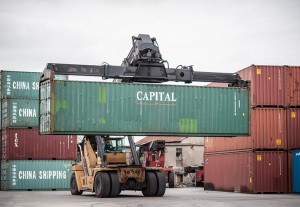Containers are for loading and transporting goods with different methods (land, sea, air, rail…). The role of the container is to make freight transport easier, as well as to protect it from the elements; with refrigerated containers, they also ensure optimum conditions to keep the goods from degrading. Container dimensions are standardised with ISO regulation 668 to facilitate handling; this regulation standardises exterior container measurements, and if applicable, dimensions with the doors open, as well as other details.
In regards to multimodal transport, certain kinds of specific containers are used that can be transported with different methods, all without breaking or handling the freight. In this article, we are going to look at the containers most used in multimodal transport.
Bulk container
Normally, this is used to transport bulk freight. It has openings for upper loading, as well as at the bottom, to make emptying it easier. This container is appropriate for transporting grain and other solid bulk goods.
This container measures 20 feet and can transport 21.2 tonnes.
Cistern or tank container
This type of container is appropriate for transporting bulk liquids, as well as liquid gases. This is a tank protected by a steel frame, forming a parallelepiped; this means that the container can be stacked and transported with several different locomotion methods more comfortably and safely.
The cistern container’s steel tank, normally coated in polyurethane and aluminium, is appropriate for transporting dangerous goods. It can transport up to 26,000 litres and has valves at the top and bottom to make it easier to load and unload goods.
Open-side container
This container opens on the side, making it easier to put highly voluminous goods inside. It is normally used to transport heavy machinery, pipes, special equipment, etc.
Open-top half-height container
The top part of this container is open, and it is shorter than other containers (1.29 instead of 2.6 m). It is used to transport very heavy and voluminous goods; it is appropriate for transporting minerals or semi-finished materials.
Flat platform
This is a platform without a roof or walls; it may be 20 or 40 feet long, and is used to transport goods that are so voluminous that they cannot fit in a normal container through doors, the roof or the sides. After placing the freight on the platform, it is covered with a resistant canopy.
Igloo container
The igloo container is specially adapted for air transport, since its rounded edges adapt to the shape of the fuselage in airplanes designed to carry freight.
Swap box
The swap box is sized so that it can be transported by lorries on roadways (which is not possible with containers). Originally, they could not be hoisted or stacked, but now there are models that can be.
As we can see, there is a huge variety of containers to transport our freight; according to the type, the transport methods to move it and other practical aspects, we would select one or the other. Having a logistics operator in charge of selecting the most appropriate one is essential for our goods to reach their destination in perfect condition.


